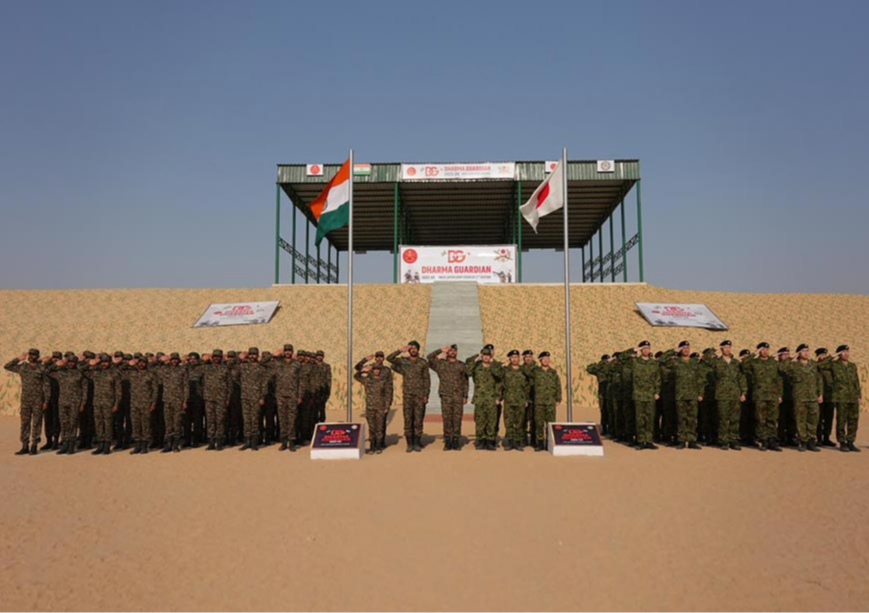India and Japan recently began their “Dharma Guardian” joint army exercise at India’s Mahajan field firing ranges in the western state of Rajasthan. This is the fifth edition of the exercise between the Indian Army and the Japanese Ground Self-Defense Force and will continue for a month, ending in the second week of March. The exercise, held in India and Japan alternatively, is a reflection of the enhanced bilateral security and strategic cooperation between the two countries
According to a press release from the Indian Ministry of Defense, the goal of the exercise is to promote military cooperation as well as to “enhance combined capabilities to execute joint operations in semi-urban environment under Chapter VII of United Nations Charter.” Chapter VII of the U.N. Charter deals with actions in relation to maintenance of peace, violations of peace, and acts of aggression. In the Indo-Pacific context, there are a number of issues that come into play including China’s belligerent behavior, its use of military force against India as well as in the South and East China Seas, and North Korea’s threats of use of military force against its neighbors.
The first Dharma Guardian exercise was held in November 2018 at the Counter-Insurgency and Jungle Warfare School (CIJWS) in Vairengte, Mizoram in northeast India. While the overall goal has remained the same in terms of developing interoperability between the two forces, in recent years the exercise has become more complex and has contributed to better familiarization between the Indian and Japanese army personnel as well as a healthier appreciation of and respect for each other’s military practices and cultures. This is important if the two countries are to engage in any kind of joint operations in the Indo-Pacific, as Indian and American forces did in the aftermath of the 2004 tsunami.
The first Dharma Guardian exercise was held in November 2018 at the Counter-Insurgency and Jungle Warfare School (CIJWS) in Vairengte, Mizoram in northeast India.
Dharma Guardian will focus a great deal on a “high degree of physical fitness, joint planning, joint tactical drills and basics of special arms skills.” The Additional Directorate General of Public Information, IHQ of MoD (Army) in a tweet said that the joint military exercise “aims to enhance interoperability in joint tactical-level operations in Semi-Urban Environment, under the United Nations mandate.” The personal connections developed through such military interactions have the potential to serve the long-term interests of both countries. The aim is also to develop a common or even a shared understanding of the threats that are enunciated in the official political and strategic documents of both countries. This, in essence, will augment the overall tone and tenor of defense cooperation between India and Japan, thus adding to further strengthening of the overall bilateral partnership.
The press release said that the tactical drills at the exercise will include setting up of temporary operating base, establishing an intelligence, surveillance and reconnaissance (ISR) grid, creating a mobile vehicle check post, implementing cordon and search operations in a hostile village, heliborne operations and house intervention drills. At the site of the exercise, there is a weapon and equipment display organized demonstrating India’s “Atmanirbhar Bharat” initiative and its overall augmented defense industrial wherewithal.
Japan has sent a contingent of 40 personnel from the 34th Infantry Regiment and the Indian Army contingent is being represented by a battalion from the Rajputana Rifles. Lieutenant General Togashi Yuichi, commanding general of the Eastern Army of the Japanese Ground Self-Defense Force, is scheduled to visit India and will also visit the firing ranges in Rajasthan on March 3 and observe the combat shooting demonstration, special heliborne operation (SHBO), as well as the house intervention drills undertaken by the two armies.
While Dharma Guardian brings together the Indian and Japanese land-based forces, JIMEX is a maritime exercise involving the two navies.
The Japan-India security partnership has been strengthening year after year. This is demonstrative of the kind of military engagements and strategic dialogues that have been put in place by the political leadership of both countries. While Dharma Guardian brings together the Indian and Japanese land-based forces, JIMEX is a maritime exercise involving the two navies. In a sign of enhancing the military cooperation in the air domain, India and Japan began “Veer Guardian-2023” involving the Indian Air Force and the Japan Air Self Defense Force from January 2023.
The bilateral maritime exercise, JIMEX, the oldest and possibly one of the more complex engagements, has been held since 2012. This year’s Dharma Guardian is the fifth iteration of the army-to-army exercise. Veer Guardian, the air exercise, is the newest, debuting last year. In fact, the decision on Veer Guardian was taken at the second 2+2 foreign and defense minister talks held in Tokyo in September 2022, when the two countries agreed on the need to enhance their defense cooperation.
The military engagements between India and Japan have been on a steady path in line with their political and strategic goals for their partnership in ensuring a stable and secure Indo-Pacific and preventing hegemony in Asia.
This commentary originally appeared in The Diplomat.
The views expressed above belong to the author(s). ORF research and analyses now available on Telegram! Click here to access our curated content — blogs, longforms and interviews.




 PREV
PREV


